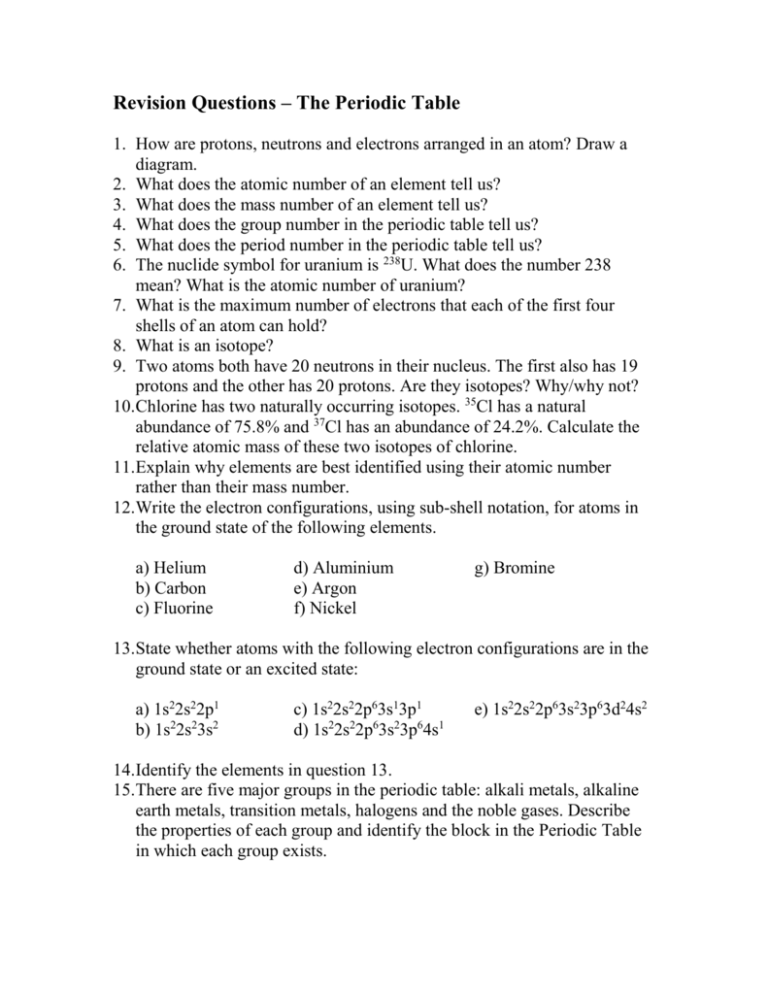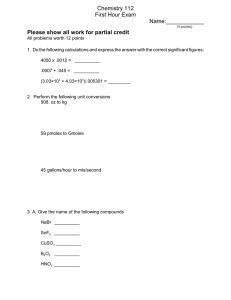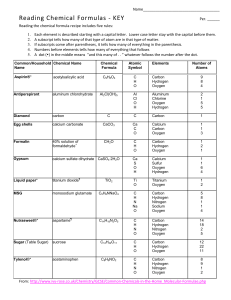Revision Questions – The Periodic Table
advertisement

Revision Questions – The Periodic Table 1. How are protons, neutrons and electrons arranged in an atom? Draw a diagram. 2. What does the atomic number of an element tell us? 3. What does the mass number of an element tell us? 4. What does the group number in the periodic table tell us? 5. What does the period number in the periodic table tell us? 6. The nuclide symbol for uranium is 238U. What does the number 238 mean? What is the atomic number of uranium? 7. What is the maximum number of electrons that each of the first four shells of an atom can hold? 8. What is an isotope? 9. Two atoms both have 20 neutrons in their nucleus. The first also has 19 protons and the other has 20 protons. Are they isotopes? Why/why not? 10.Chlorine has two naturally occurring isotopes. 35Cl has a natural abundance of 75.8% and 37Cl has an abundance of 24.2%. Calculate the relative atomic mass of these two isotopes of chlorine. 11.Explain why elements are best identified using their atomic number rather than their mass number. 12.Write the electron configurations, using sub-shell notation, for atoms in the ground state of the following elements. a) Helium b) Carbon c) Fluorine d) Aluminium e) Argon f) Nickel g) Bromine 13.State whether atoms with the following electron configurations are in the ground state or an excited state: a) 1s22s22p1 b) 1s22s23s2 c) 1s22s22p63s13p1 d) 1s22s22p63s23p64s1 e) 1s22s22p63s23p63d24s2 14.Identify the elements in question 13. 15.There are five major groups in the periodic table: alkali metals, alkaline earth metals, transition metals, halogens and the noble gases. Describe the properties of each group and identify the block in the Periodic Table in which each group exists. 16.Name an element with properties similar to those of: a) Carbon b) Iodine c) Rubidium d) Phosphorus 17.Define these trends in the Periodic Table: c) 1st Ionization Energy a) Atomic Radius b) Electronegativity 18.The following is a list of elements: a) Oxygen b) Fluorine c) Sodium d) Barium e) Neon f) Titanium Which of the above elements has the: Greatest atomic radius? Greatest electronegativity? Greatest 1st ionization energy? 19.If calcium oxide is 71.5% calcium and 28.5% oxygen; calculate: a) The mass of calcium in 4.6 g of calcium oxide b) The mass of oxygen in 0.46 g of calcium oxide c) The mass of oxygen you would need to react with 10 g of calcium to form calcium oxide 20.Suppose you reacted 10 g of calcium with 10 g of oxygen until all the calcium was converted into calcium oxide. Use your answer to question 19c to calculate the mass of oxygen you would have left over after the reaction. 21. How many particles are there in 1 mole of any substance? What name is given to this number? 22.What is the molar mass of each of the following: a) Iron (Fe) b) Sulfuric acid (H2SO4) c) Sodium oxide (Na2O) d) Zinc nitrate (Zn(NO3)2) e) Glycine (H2NCH2COOH) f) Aluminium sulfate (Al2(SO4)3) g) Hydrated iron(III) chloride (FeCl3.6H2O) 23.What is the mass of: a) 0.06 mol of ethane (C2H6) b) 0.32 mol of glucose (C6H12O6) c) 6.8 x 10-3 mol of urea ((NH2)2CO) d) 6.12 mol of copper atoms (Cu) 24.For each of the following molecular substances calculate: The amount of substance in moles The number of molecules The total number of atoms a) 4.2 g of phosphorus (P4) c) 0.32 g of hydrogen chloride (HCl) b) 75 g of sulfur (S8) d) 2.2 x 10-2 g of glucose (C6H12O6) 25.Which of the following metal samples has the greatest mass? a) 100 g copper b) 4.0 mol of iron atoms c) 1.2 x 1024 atoms of silver 26.Determine the percentage of carbon in the following compounds: a) Naphthalene (C10H8) b) Ethanoic acid (CH3COOH) c) Aspirin (C6H4(OCOCH3)COOH) d) Urea (NH2CONH2) 27.Determine the empirical formulas for the compounds with the following compositions: a) 42.9% carbon, 57.1% oxygen b) 54.5% carbon, 9.1% hydrogen, 36.4% oxygen c) 1.72 g iron, 1.48 g sulfur, 3.02 g oxygen d) 9.6 g carbon, 0.67 g hydrogen, 4.7 g chlorine e) 4.42 g carbon, 0.842 g hydrogen 28.A compound used as a solvent for nitrocellulose, resins and dyes has the following composition by mass: 32% carbon, 6.7% hydrogen, 18.7% nitrogen, 42.6% oxygen. Find the empirical formula of the compound. 29.Determine the molecular formulas of the compounds with the following compositions and relative molar masses: a) 82.75% carbon, 17.25% hydrogen; Mr = 58 gmol-1 b) 43.66% phosphorus, 56.34% oxygen; Mr = 284 gmol-1 c) 40.0% carbon, 6.7% hydrogen, 53.3% oxygen; Mr = 180 gmol-1 d) 0.164 g hydrogen, 5.25 g sulfur, 9.18g oxygen; Mr = 178 gmol-1










